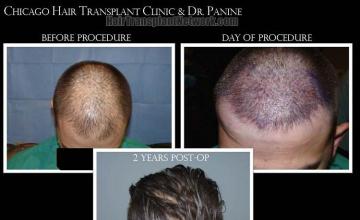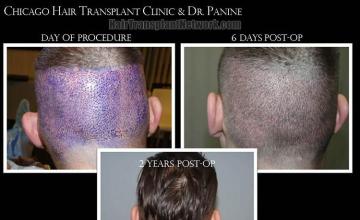Procedure detail
This gentleman had diffused thinning from his hairline to his crown, and was heading towards a class 5. After establishing his medical history and understanding the progression of his hair loss, I diagnosed his condition as Androgenetic Alopecia (male pattern baldness), ruling out any other possible dermatological or medical conditions which can cause hair loss. His goal was to reconstruct his hairline, add density from the hairline to the crown and wanted to be able to keep his donor area very short.
I needed to take in to consideration his age of 37, present degree of hair loss and possible further hair loss. We both agreed that it would be best to still keep some temple recession so it looks appropriate for him today but also looks good as he continues to age. I advised him that it would be best for his situation to have a FUE procedure since his goal was to be able to keep the back very short That said, I also advised him that it would have to be done over 2 procedures. I also explained that there was a possibility that he could lose more of his own hair. If this was to happen, the transplanted hair would be able to stand alone and still look natural, but he would possibly need another procedure to replace what he lost.
During his 1st procedure we transplanted 2,092 FUE/ grafts. The breakdown was 1,063 single hair grafts, 906 double hair grafts and 123 triple hair grafts. All of the grafts in his 1st procedure were concentrated into the frontal 1/3 of his scalp. His 2nd procedure was completed one year later and we addressed the mid and crown area. We transplanted 2,079 FUE/grafts with his 2nd procedure. The breakdown was 968 single hair grafts, 897 double hair grafts and 214 3 hair grafts. The patient is extremely happy with his results and can style his hair exactly the way he wants to.
Bald class

Norwood stage 5
Occurs when the connecting bridge of hair disappears leaving a single large bald area on the front and top of the scalp. The hair on the sides of the scalp remains relatively high.





